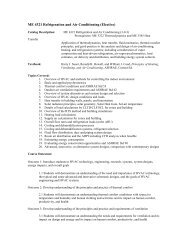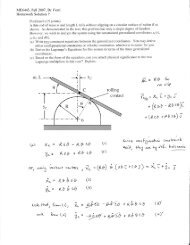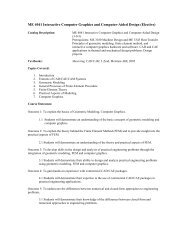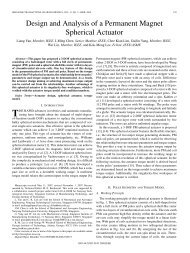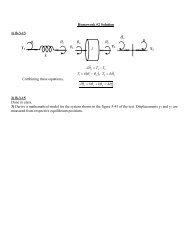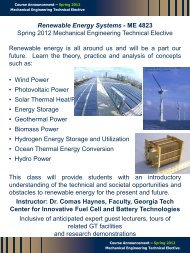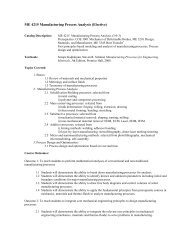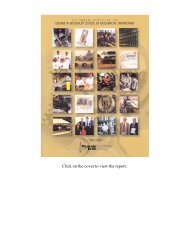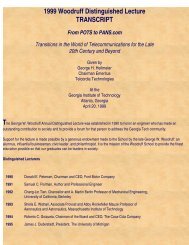Transcript - The George W. Woodruff School of Mechanical ...
Transcript - The George W. Woodruff School of Mechanical ...
Transcript - The George W. Woodruff School of Mechanical ...
Create successful ePaper yourself
Turn your PDF publications into a flip-book with our unique Google optimized e-Paper software.
1996 <strong>Woodruff</strong> Distinguished Lecture<strong>Transcript</strong>"Yes, But Will It Work in <strong>The</strong>ory?"ByNorman R. AugustineChairman and Chief Executive OfficerLockheed Martin Corporation<strong>The</strong> <strong>George</strong> W. <strong>Woodruff</strong> Annual Distinguished Lecture was established in 1990 to honor an engineerwho has made an outstanding contribution to society and to provide a forum for that person to addressthe Georgia Tech community.Support for the lecture is made possible by a generous endowment made to the <strong>School</strong> by the late<strong>George</strong> W. <strong>Woodruff</strong>: an alumnus, influential businessman, civic leader, and philanthropist. It is themission <strong>of</strong> the <strong>Woodruff</strong> <strong>School</strong> to provide the finest education possible so that our graduates can beleaders in society.Distinguished Lecturer1990 Donald E. Petersen, Chairman and CEO, Ford Motor Company1991 Samuel C. Florman, Author and Pr<strong>of</strong>essional Engineer1992 Chang-Lin Tien, Chancellor and A. Martin Berlin Pr<strong>of</strong>essor<strong>of</strong> <strong>Mechanical</strong> Engineering, University <strong>of</strong> California, Berkeley1993 Sheila E. Widnall, Associate Provost and Abby Rockefeller Mauze Pr<strong>of</strong>essor<strong>of</strong> Aeronautics and Astronautics, Massachusetts Institute <strong>of</strong> Technology1994 Roberto C. Goizueta, Chairman <strong>of</strong> the Board and CEO, <strong>The</strong> Coca-Cola Company
1995 James J. Duderstadt, President, <strong>The</strong> University <strong>of</strong> Michigan1996 Norman R. Augustine, Chairman and CEO, Lockheed Martin Corporation1997 Charles M. Vest, President and Pr<strong>of</strong>essor <strong>of</strong> <strong>Mechanical</strong> Engineering,Massachusetts Institute <strong>of</strong> TechnologyNorman R. AugustineNorman R. Augustine is Chairman and Chief Executive Officer <strong>of</strong>Lockheed Martin Corporation. Mr. Augustine previously served as President<strong>of</strong> the Corporation, a position he assumed upon the merger <strong>of</strong> Lockheed andMartin Marietta in March 1995. Before the merger, Mr. Augustine served asChairman and Chief Executive Officer <strong>of</strong> Martin Marietta Corporation from1988-1995.Mr. Augustine is chairman <strong>of</strong> the Board <strong>of</strong> Governors <strong>of</strong> the American Red Cross, a past chairman <strong>of</strong>the NASA Space Systems and Technology Advisory Committee, past chairman <strong>of</strong> the Defense ScienceBoard, and past chairman <strong>of</strong> the Aerospace Industries Association Board <strong>of</strong> Governors. He is also theformer chairman <strong>of</strong> the Council <strong>of</strong> Trustees <strong>of</strong> the Association <strong>of</strong> the U.S. Army, and the formerpresident <strong>of</strong> the Boy Scouts <strong>of</strong> America. He has been a member <strong>of</strong> the Air Force Scientific AdvisoryBoard and has chaired advisory councils for Princeton University, the American University, and theLincoln Laboratory <strong>of</strong> the Massachusetts Institute <strong>of</strong> Technology.Mr. Augustine is an Honorary Fellow and Past President <strong>of</strong> the American Institute <strong>of</strong> Aeronautics andAstronautics, a Fellow <strong>of</strong> the American Astronautical Society, an Honorary Fellow <strong>of</strong> the Society forTechnical Communication, a Senior Member <strong>of</strong> the International Academy <strong>of</strong> Astronautics, a formerchairman <strong>of</strong> the National Academy <strong>of</strong> Engineering, and a Fellow <strong>of</strong> the Institute <strong>of</strong> Electrical andElectronic Engineers.Mr. Augustine has four times received the Department <strong>of</strong> Defense's highest civilian award, theDistinguished Service Medal, and has also received the James Forrestal Memorial Award <strong>of</strong> the NationalSecurity Industrial Association, the Defense Meritorious Service Medal, the Army Distinguished Service
Medal, and the Air Force Exceptional Service Medal.He received a bachelor's degree in aeronautical engineering (magna cum laude) in 1957 and amaster's degree in 1959, both from Princeton University. He was elected to Phi Beta Kappa, Tau Beta Pi,and Sigma Xi. He holds ten honorary doctorate degrees and has authored or co-authored two books.[Editor's Note: Mr. Augustine used slides to illustrate the points made in his lecture. Due to productionlimitations, the slides are not included here, but the text <strong>of</strong> his lecture has been adapted slightly tocompensate for the lack <strong>of</strong> visual references.]It is a great honor and privilege to be invited to deliver the 1996 <strong>Woodruff</strong> Distinguished Lecture, andthank you so much for that generous introduction. In all candor, I was hoping you would plug my book,Augustine's Laws. You left that one thing out. By the way, if any <strong>of</strong> you happen to have a copy, let mecongratulate you on being a member <strong>of</strong> a very select, small group. I am told that among the most soughtaftercollector's items among literary enthusiasts are unsigned copies <strong>of</strong> my book. Shortly after the bookwas published, I received a letter from Laurence Peter <strong>of</strong> Peter Principle fame. He said that I hadundermined his entire life's work ... having risen not one but two levels above my level <strong>of</strong> competence!It is also a great pleasure to be here not only because <strong>of</strong> the contributions <strong>of</strong> the individual for whom thelecture is named but also to be here again at Georgia Tech. A number <strong>of</strong> my Lockheed Martin colleaguesare Tech graduates, including our chief financial <strong>of</strong>ficer, the head <strong>of</strong> our mergers and acquisitionsdepartment, and the head <strong>of</strong> one <strong>of</strong> our major companies. So I do feel a great kinship with all <strong>of</strong> you.IntroductionI thought this afternoon that I would address the weighty question, "Yes, but will it work in theory?" Bythat I mean that there are a lot <strong>of</strong> tough, real-world challenges engineers face that are not terribly elegantand that do not lend themselves to theoretical solutions. So I thought I would address some <strong>of</strong> those realworldchallenges today because there are important lessons to be learned. <strong>The</strong>se are the lessons that youdon't get from parchment degrees. <strong>The</strong>y are not lessons <strong>of</strong> great philosophical value. <strong>The</strong>y are thelessons <strong>of</strong> scar tissue, the lessons <strong>of</strong> experience. And had I learned these lessons in school, I could havesaved my employers literally billions <strong>of</strong> dollars over my career. Hopefully, you will find these lessons <strong>of</strong>some value in your careers.First <strong>of</strong> all, let me take a step back in the pr<strong>of</strong>ession <strong>of</strong> engineering. I like to think <strong>of</strong> our pr<strong>of</strong>ession asbeginning with the Structural Era, which was an era <strong>of</strong> great accomplishment dating back some 4,500years to the construction <strong>of</strong> the pyramids. <strong>The</strong> era includes successes that even today seem remarkable,
such as the building <strong>of</strong> the Roman aqueducts and the Taj Mahal, but also encompasses more modernfeats such as the Eiffel Tower, the great dams, the great bridges, today's superhighways, and the"Chunnel" connecting England and France.Following the Structural Era, engineering evolved into the <strong>Mechanical</strong> Era, where we have usedmachines to augment human muscle. Early examples would be the steamboat and the railroad. <strong>The</strong>automobile replaced the tried and true horse in many roles, and the airplane was one <strong>of</strong> the products <strong>of</strong>my field <strong>of</strong> aeronautical engineering. In this era, the culmination thus far would have to be the landingon the moon.During this period <strong>of</strong> great accomplishment, there was a burgeoning new field that grew out <strong>of</strong> the<strong>Mechanical</strong> Era, and this was the Information Era - or, more precisely, the Electronic Era. <strong>The</strong> principalthrust <strong>of</strong> this era became one <strong>of</strong> helping to augment the human brain as well as human muscle. We havecome a very long way from the first digital computer - the ENIAC - in 1946. With 18,000 vacuum tubesin one room and another room full <strong>of</strong> air conditioning equipment just to keep the machine cool, ENIACwas an astonishing piece <strong>of</strong> equipment. Technicians had full-time jobs running up and down the aislesjust changing the vacuum tubes that had burned out.A few short years after ENIAC, the transistor was invented, and after that scientists starting doing someamazing things with the sand that people had walked on for centuries and never thought much about. Byvirtue <strong>of</strong> the work <strong>of</strong> two friends <strong>of</strong> mine - and probably some <strong>of</strong> yours in this room - the commonelement silicon has truly revolutionized the world. We learned to build integrated circuits in manydifferent shapes and different sizes with different functions, allowing us to carry around more computingpower in our wristwatches today than existed in the entire world the year I graduated from college.Today, a bit <strong>of</strong> storage costs about 1/100th <strong>of</strong> one percent <strong>of</strong> what it cost just 25 years ago ... and theprice is still plummeting. As <strong>George</strong> Heilmeier, CEO <strong>of</strong> Bellcore, has pointed out, "If the automotiveindustry had progressed at the same rate as the semiconductor industry, a Rolls Royce would cost onlythree dollars, and there would be no parking problem because automobiles would be one-quarter <strong>of</strong> aninch on a side!"<strong>The</strong> Velocity <strong>of</strong> ChangeThat extraordinary pace <strong>of</strong> change is what makes engineering so very exciting. <strong>The</strong> pace <strong>of</strong> progress inthe aerospace field is further suggested by the fact that the famous first flight <strong>of</strong> the Wright Brotherscould have taken place inside the large orange fuel tank that forms the structural backbone <strong>of</strong> the SpaceShuttle. By the same token, Dr. Robert Goddard's early, famous rocket launch from a cabbage patch inMassachusetts reached a peak altitude <strong>of</strong> just one-half the height <strong>of</strong> the Apollo launch vehicle, while thelaunch vehicle was still standing on the pad.<strong>The</strong> velocity <strong>of</strong> change is one <strong>of</strong> the things that makes it so difficult to project the future <strong>of</strong> engineering.As evidence, let me cite pronouncements <strong>of</strong> some <strong>of</strong> history's greatest intellects. I will warn you: <strong>The</strong>irprophecies weren't all that good. For example, Napoleon dismissed Robert Fulton's claim <strong>of</strong> a steam-
powered ship: "What, sir, would you make a ship sail against the wind and currents by lighting a bonfireunder her deck? I pray you excuse me. I have no time to listen to such nonsense."Or consider the pronouncement <strong>of</strong> Dr. Dionysus Lardner, pr<strong>of</strong>essor at University College in London, onthe prospects <strong>of</strong> a new form <strong>of</strong> transportation: "Rail travel at high speed is not possible becausepassengers, unable to breathe, would die <strong>of</strong> asphyxia." Or hear the opinion <strong>of</strong> the commander <strong>of</strong> thearmy's cavalry in 1938, just before World War II: "We must not be misled to our detriment to assumethat the untried machine can displace the proved and tried horse." Or listen to a great aviator speakingabout the pr<strong>of</strong>ession: "Flying machines will eventually be fast; they will be used in sport but they shouldnot be thought <strong>of</strong> as commercial carriers."Humankind has also made huge mistakes in the other direction, namely being overoptimistic. Myfavorite example is that <strong>of</strong> Mr. Lewyt <strong>of</strong> the Lewyt Home Appliance Company. In 1955, I was asophomore in college, and this was his projection: "Nuclear-powered vacuum cleaners will be a realitywithin ten years."Progress and Reversal<strong>The</strong> trail <strong>of</strong> progress has never been smooth. It has <strong>of</strong>ten been accompanied by brief, but significant,reversals that had to be overcome. <strong>The</strong>re is a classic observation that I think could be a great model forthe entire field <strong>of</strong> engineering: "You canna expect to be baith grand and comfortable."Some <strong>of</strong> these difficult reversals along the way, for example, stem from the notion that you shouldactually pay attention to the foundation <strong>of</strong> that upon which you are building. For example, there was thegreat engineering project, the Vasa, a grand sailing ship built in Sweden following engineering drawingspersonally approved by the king himself. <strong>The</strong> Vasa was built, and on the day it was to be launched, ahuge crowd gathered at the harbor in Stockholm. Bands played and the Vasa went down the gangways,proceeded about 100 yards out into the harbor, rolled over, and sank. Which just shows that in spite <strong>of</strong>the playing <strong>of</strong> bands and having the king approve the drawings, the laws <strong>of</strong> nature still must be observed.<strong>The</strong>n there are some engineering concepts that are fundamentally bad ideas - for example, the idea <strong>of</strong>building a dirigible three times the length <strong>of</strong> a 747 aircraft, filling it with hydrogen, and then allowingpeople to fly in it. Under the circumstances, the explosion and crash <strong>of</strong> the Hindenberg was almostinevitable. <strong>The</strong> amazing thing was that 68 people survived the ensuing conflagration.Interdisciplinary Scar Tissue<strong>The</strong>n there's the obvious lesson we've learned over the years about the importance <strong>of</strong> interdisciplinarystudies. And this is a lesson that's becoming even more relevant as the engineering projects we designand build become ever more complex. Some <strong>of</strong> you may recall the classic example <strong>of</strong> the TacomaNarrows Bridge, built over a deep gorge in Washington state, which performed beautifully - until the
wind started to blow. That was when we discovered that aerodynamics actually has something to do withbridge building - much to the regret, <strong>of</strong> course, <strong>of</strong> those who designed the bridge - and the bridgecollapsed in a most spectacular fashion.Admittedly, sometimes we as engineers have been slow to learn. When a British Comet, the firstcommercial jet airliner, unexpectedly crashed, one scientist suggested that we needed to pay attention toa phenomenon called "metal fatigue." But it took three crashes in one year before the engineers couldentertain the thought that such a thing could actually bring down such a technologically advanced piece<strong>of</strong> equipment. Eventually, engineers designing airliners learned to compensate for metal fatigue - and athousand other factors - and today airline transportation is the safest way to travel.Sadly, so many engineering lessons are learned as a result <strong>of</strong> serious failures, such as happened atChernobyl. <strong>The</strong>re, we learned the importance <strong>of</strong> having independent containers, and also <strong>of</strong> not havingoperators doing freelance experiments.One <strong>of</strong> the key engineering lessons we've learned in terms <strong>of</strong> how to avoid these problems has to do withtesting - and I'm going to return to this subject from time to time during my presentation. One <strong>of</strong> the firsttests I became aware <strong>of</strong> with regard to an engineering project had to do with the building <strong>of</strong> the CrystalPalace in London in the last century. This was a marvelous engineering and architecturalaccomplishment, and, at the time, it was written up widely in the newspapers. <strong>The</strong> way it was tested, andI've taken this from a contemporary account, is as follows: "<strong>The</strong> first experiment was that <strong>of</strong> placing adead load <strong>of</strong> about 42,000 pounds ... consisting <strong>of</strong> 300 workmen <strong>of</strong> the contractors, on the floor and theadjoining approaches."Now that's known as the "incentive system," and it was an early version <strong>of</strong> the theory that the bestparachute packers are those who themselves jump out <strong>of</strong> airplanes. That newspaper account carried aphotograph and some additional information <strong>of</strong> another experiment at the Crystal Palace: "<strong>The</strong> fourthexperiment - and that which may be considered the most severe test - was that <strong>of</strong> packing closely thatsame load <strong>of</strong> men, and causing them to jump up and down together for some time."I hasten to add that you will note that the engineers did not participate in any <strong>of</strong> these tests.<strong>The</strong> Lessons <strong>of</strong> Scar TissueSo, with that as a quick scan <strong>of</strong> how we got to where we are today, what are some <strong>of</strong> the lessons that weshould perhaps try to learn from these experiences? As I mentioned earlier, we need to leave the realm<strong>of</strong> theory and the realm <strong>of</strong> the classroom and go out into the cold, hard world, and into the school <strong>of</strong> hardknocks - and study scar tissue.Most <strong>of</strong> this scar tissue is derived from projects with which, I have to say with some regret, I had someinvolvement - including some which occurred during my time as Assistant Secretary <strong>of</strong> the Army. Some<strong>of</strong> what I will describe, I'm happy to report, I didn't have anything to do with. Some <strong>of</strong> which I will
describe, I got there after the fact to try to help figure out, as part <strong>of</strong> an advisory board, what hadhappened. I'm going to do this in the form <strong>of</strong> drawing management lessons from engineering examples.So let's launch; we've got a lot to cover.Conceptual Brilliance Doesn't Blind the Laws <strong>of</strong> PhysicsNature is a very honest judge, which quickly becomes apparent in the course <strong>of</strong> what might be calledHousekeeping 101. <strong>The</strong> failure <strong>of</strong> Housekeeping 101 has cost billions <strong>of</strong> dollars in failures that I'maware <strong>of</strong> - and certainly billions more that lie outside my experience. For example, a little bit <strong>of</strong>contamination on the grid <strong>of</strong> a storage tube caused a failure <strong>of</strong> a spacecraft. A little gold particle thatshorted out two electric circuits on a tiny chip was smaller than the cross section <strong>of</strong> a human hair.One <strong>of</strong> the most repeated causes <strong>of</strong> failure has nothing to do with theory or calculations. It has to do withthis kind <strong>of</strong> problem: FOD, we call it in the aerospace industry, foreign object damage. Some years ago,I was involved in a jet engine development program when I was in the Pentagon. <strong>The</strong> contractor washaving problems on the test stand <strong>of</strong> his new engine. <strong>The</strong> mechanics would work on it, and then theywould forget and leave a screwdriver or a pair <strong>of</strong> pliers or a bolt on the inlet <strong>of</strong> the engine. <strong>The</strong>y'd crankup the engine and it would blow up, which got to be very frustrating.So the contractor's management put in a common-sense procedure: Before that engine on the test standwas fired up, an engineer must go inside the inlet with a flashlight and personally inspect it, come out,and personally sign the log that there was no foreign object inside. <strong>The</strong> very first time after they put thatprocedure in practice, the engine blew up. Guess what was left inside the engine? You got it: It was theflashlight.<strong>The</strong> Devil Is in the DetailsWhich brings me to this lesson, for which I could give you more examples than you could stand in oneafternoon. Let me give you a few. This is about a spacecraft that was launched a number <strong>of</strong> years ago. Ithad, <strong>of</strong> course, a guidance system, and in the guidance system there was a lot <strong>of</strong> s<strong>of</strong>tware in thecomputer. <strong>The</strong>re was a "failed Doppler radar test" sequence which was to be used only if the Dopplerradar failed during the flight. Since this was an interplanetary mission, there was an infinite number <strong>of</strong>paths that one would have to go through to totally test this sequence, but it was tested as thoroughly ashumanly possible. Once it had been launched and was in flight, not only did the Doppler radar fail, but itgot into a sequence, a loop that had not been tested, and it turned out that in that loop there was a hyphenmissing in one <strong>of</strong> the thousands <strong>of</strong> lines <strong>of</strong> s<strong>of</strong>tware code. Because <strong>of</strong> that missing hyphen, the spacecrafttook <strong>of</strong>f on its own into interstellar space, and nobody will see it again until, perhaps, a future Star Trekmovie encounters it.Leave Nothing to Chance
Some years ago there was another spacecraft that, once it was in orbit, blew a fuse. One <strong>of</strong> thedifficulties in my pr<strong>of</strong>ession is that we don't have recalls like they have in Detroit, where you can recallthe spacecraft back to Earth to fix it. In this case it happened to be near the Earth, so we had an astronautgo up to fix the fuse, the plan being to open a panel on the satellite and put in a replacement fuse. BruceMcCandless was the astronaut who was chosen to carry out the task. As a matter <strong>of</strong> fact, I remember thelast thing I asked Bruce before he left on the Space Shuttle was whether that panel had standard orPhillips-head screws on it, and was he sure he had the right screwdriver? My question wasunintentionally prophetic.It turned out we did have a problem when the astronaut got to the satellite and tried to dock with it. Hewas using the Manned Maneuvering Unit (MMU), which allows an astronaut to move around freely inthe weightlessness <strong>of</strong> space. <strong>The</strong> MMU had a docking device designed specially for that satellite, and wehad practiced the procedure a zillion times on Earth. But when he actually got to the docking, he couldn'tget the device to work. Fortunately, after manhandling the satellite, he was finally able to replace thefuse. But all the stuff we'd given him didn't help.With Bruce safely back on the ground, we did a postmortem on the mission and tried to figure out whythe MMU couldn't dock. We went back into the files. We always take photographs as we assemble thesesatellites. Using old "as-built" photographs, it showed that the assembler applied gold foil around most<strong>of</strong> the satellite for thermal reasons, attaching the gold foil with rivets. And the assembler, as luck wouldhave it, apparently had no idea that one place he put a rivet was directly over the docking device, and sowe were unable to dock. <strong>The</strong> message, <strong>of</strong> course, is "leave nothing to chance." We should have told theassembler where to put those rivets.Murphy Was an OptimistAt the very first launch <strong>of</strong> the Space Shuttle, in 1981, there were millions <strong>of</strong> people watching ontelevision, and there were an equally impressive number <strong>of</strong> people at Cape Canaveral awaiting thelaunch. Quite appropriately, the designers <strong>of</strong> the Shuttle had built great redundancy into the new craft,including a total <strong>of</strong> five computers - four general purpose computers and a back-up flight computer. <strong>The</strong>trick was that the timing on those computers had to be perfectly synchronized.On the very first attempted launch <strong>of</strong> the Shuttle, they could not get the computers to synchronize. It wasa dreadfully hot day, and most <strong>of</strong> us were standing around outside the control center in the blazing sunfor five or six hours, while the engineers tried to figure out why the computers wouldn't cooperate. Oneengineer said all you have to do is unplug the computers and plug them in again and it'll work fine.Nobody was willing to accept that, but it turned out later he was correct. To the great credit <strong>of</strong> thescientists and engineers working the problem - and particularly to the appreciation <strong>of</strong> the astronautsonboard - the programmers didn't take the easy way out. <strong>The</strong>y wanted to know why the computerswould not synchronize.After much discussion and review, the riddle was finally solved. What had happened? In the original
configuration <strong>of</strong> the s<strong>of</strong>tware, there was an event that had to be initiated and there was a one-secondlongwindow during which this event could be initiated. <strong>The</strong>re was a fifty-millisecond delay built in, andthen the event would take place. If the event took place before 60.522 milliseconds from the end <strong>of</strong> thewindow, the sequence would work effortlessly. If the event was initiated after that point, the computerhad been programmed to try it twice more - and then shut down because something obviously waswrong. That was the way it was designed to work.For some reason - and I don't remember any longer what the reason was - the engineers "improved" thedesign. Boy, that's sudden death when engineers improve designs! Half the failures we've had in ourlives have been because <strong>of</strong> that. <strong>The</strong> engineers, for some reason, decided to make the 50 milliseconds80.26 milliseconds. And then they tested that in the system tests. By this point they had completed most<strong>of</strong> the systems tests, but they went back and re-tested this change. <strong>The</strong>y did it several times, entered thesequence at random times, and everything worked just fine.As luck would have it, all the tests were just fine, but on the very first flight when they entered thesequence, they randomly hit at the very tail end <strong>of</strong> the window. <strong>The</strong>re was only one chance in 67 thatthis could happen, and as Murphy would have predicted, it had to happen on the first flight. As a result,the system shut down and we had to wait a full day to figure out what had gone wrong. So in spite <strong>of</strong>having all these computers to protect you and give you backup, it doesn't always work.My personal favorite example <strong>of</strong> Murphy's ubiquitous presence occurred in a '69 Mustang that I boughtwhen it was brand new. It's a gorgeous car. <strong>The</strong>re was a 25-cent fuse in my Mustang, which the peoplewho designed the car put in there to protect the wiring in case <strong>of</strong> a short circuit. Well, at one point I hada short circuit, and what happened was that the wiring harness melted, but the fuse was undamaged. Ihad to replace the entire wiring system, but the 25-cent fuse could be reused. No doubt somewhereMurphy was smiling over that one.<strong>The</strong>re's No Such Thing as a Random FailureEvery failure has a reason, a root cause. None <strong>of</strong> them are random. Here's an example: I happened to beworking in the Pentagon during the war in Vietnam. We had a new system called a standardantiradiation missile. It fit under the wing <strong>of</strong> the A-6 aircraft, and it was designed to "home in" on theradar signal <strong>of</strong> an enemy unit shooting SA-2 missiles at our aircraft. It was tested extensively at WhiteSands Missile Range and shipped into the field quickly because we were losing a lot <strong>of</strong> airplanes.Once the new missiles reached Vietnam, the pilots would get up over North Vietnam, an SA-2 would belaunched at them, and they'd retaliate by launching our standard arm missile at the radar. After 16seconds <strong>of</strong> flight, our missile would explode for no reason. This happened repeatedly, and we werebaffled. So we brought the missiles back from Vietnam to White Sands, we launched them again, andthey worked just great. We called in the FBI. We did everything we could think <strong>of</strong> to try and figure outwhat had happened. We found nothing wrong, so we sent some more missiles back to Vietnam foranother try. Guess what? After 16 seconds <strong>of</strong> flight, they all blew up.
We decided to go back to Square One. We started with the assembly process at the factory, trackingevery step to try to figure out what was different between the missiles that went to Vietnam and the onesthat stayed here and were tested. Well, the principal difference was that the ones sent to Vietnam had alive warhead, whereas the test missiles were fitted with telemetry in place <strong>of</strong> the warhead. And to besure we didn't mistakenly send the wrong missile to the wrong place, the General Dynamics factoryworkers put a sticker on the Vietnam-bound missiles - a sticker that said "Live Warhead." Applying thatsticker seemed to be a pretty good idea, and it was the only substantive difference we could find betweenthe two missiles.Now, one <strong>of</strong> the engineers investigating this mystery started to get interested in that sticker and did sometesting. He discovered that after 16 seconds <strong>of</strong> flight, the skin temperature <strong>of</strong> the missile at the locationwhere they applied the sticker was equal to the debonding temperature <strong>of</strong> the glue used to adhere thesticker - a finding that was kind <strong>of</strong> interesting. <strong>The</strong>n somebody discovered that the sticker wasaluminized, so that it would hold on in bad weather if it got wet. We then took a model <strong>of</strong> the missile,put it in a wind tunnel with the aluminum sticker on it, debonded the sticker, and then watched inastonishment as the sticker, due to a very strange air flow pattern, would fly up above the fin and passthrough the guard beam on the fuse. <strong>The</strong> missile's arming mechanism, thinking it was seeing a target,would detonate. In tests, it happened again and again. <strong>The</strong> mystery was finally solved, and we were ableto ship missiles to Vietnam that worked.<strong>The</strong> next lesson is one I learned early on. It was my first day at work on a real job, and a bunch <strong>of</strong>executives came in to speak to us. I only remember one thing that was said that day, and I have found itto be true throughout my career. <strong>The</strong> one thing I remember from that encounter was the followingadmonition:No Change Is a Small ChangeOne example, again very close to home, illustrates what a pr<strong>of</strong>ound statement that was. <strong>The</strong> company Iwork for builds the Titan space launch vehicle. Some years ago, we adapted a Titan to put commercialpayloads into orbit. This model was designed to carry two payloads - two spacecraft - within its largepayload fairing, and hence was designed with two ports through which the wiring and umbilical cordswere hooked up. Now, in this particular instance, there was going to be only one payload, albeit a verylarge one. <strong>The</strong> engineers had a choice <strong>of</strong> wiring the payload either through the front port or through theaft port.As it happened, the engineer on the job chose the drawings to do the wiring through the front port, andthe s<strong>of</strong>tware was designed according to that choice. That engineer was then shifted to another project.About a year and a half later, another engineer was assigned to the project and observed, "That's kind <strong>of</strong>crazy. Why should we run wires 25 feet up the side <strong>of</strong> the launch vehicle? Why not plug into the aftport?" So he redlined the drawings, changed the configuration to "improve" it, and showed that thewiring should be plugged into the aft port. <strong>The</strong> only problem was that somewhere along the line, we had
designed in an escape vent in our configuration control system, and the people who wrote the s<strong>of</strong>twarewrote it to expect the input from the front port.<strong>The</strong> launch day came, and the Titan flew beautifully. <strong>The</strong> giant vehicle separated at precisely the rightmoment, the second stage fired perfectly, and the vehicle attained the orbit just where it was supposed tobe. Everything was fine. <strong>The</strong>n we sent the signal to separate the payload, and nothing happened. Wecouldn't separate it; nothing could be done. You might ask, "Why didn't the project team catch theproblem during the systems testing that preceded the launch?" <strong>The</strong> reason for that presents anotherlesson <strong>of</strong> how things go wrong: <strong>The</strong> system tests used generic s<strong>of</strong>tware instead <strong>of</strong> the actual flights<strong>of</strong>tware. <strong>The</strong> generic s<strong>of</strong>tware, as we discovered later to our great regret, accepted input from eitherport, so the separation "worked" perfectly in theory since it wasn't particular with regard to which portgave the signal. This led to a $300 million lawsuit and kept our legal department happy for two years.Another example - this one very tragic - <strong>of</strong> there being no such thing as a small change comes to mind. Ithas to do with the infamous elevated walkways in the Hyatt Regency Hotel in Kansas City. You willrecall that one afternoon in 1981 a tea dance was being held in the atrium, and a large number <strong>of</strong> peoplewere dancing on these walkways when the structures collapsed, killing 113 people.How did this happen? <strong>The</strong> original design called for long, continuous rods with hanger connectors tohold up the walkways. When that design got to the workers who had to put it together, the workers weregiven the connectors and told that the top walkway was four stories up and the connectors were to bethreaded to appropriate heights to hold the walkways in place. You can guess what the workers saidabout the engineer who designed that. No one wanted to put up scaffolding and spend two weeksthreading connectors all the way up four stories. So on the spot, they decided to make a field change.<strong>The</strong> field change was, to a casual observer, a seemingly logical one - until you stopped to think about it abit. Instead <strong>of</strong> a long, single rod extending through the walkways to the ro<strong>of</strong>, the installers decided to cutthe rods in half and suspend the top walkway from the ro<strong>of</strong> and suspend the lower walkway from the oneabove it. A seemingly minor change, but when you think the matter through, you see that with the newdesign, the connectors supported not only its own walkway but everything suspended below it.Illustrating the problem a different way, it would be as if you had three people hanging on a rope, eachsupporting a walkway; that was the original design. After the change, the person at the top <strong>of</strong> the ropewould be supporting the whole works. It was a marginal design to begin with, and what happened was acatastrophic failure that took the lives <strong>of</strong> 113 people. No change is a small change.If It Involves Humans, Make It Foolpro<strong>of</strong>Many years ago, I became involved with a missile for which two contractors made the hardware. <strong>The</strong>rewere two major wiring harnesses that connected the separate units, and in the preflight check, it wasdiscovered that the wiring harnesses were reversed. Finding this problem in the preflight check was thegood news. <strong>The</strong> bad news was that the flight conductor gave the instruction to the contractors to reversethe wiring. You can guess what happened. Both contractors went back and reversed the wiring.
Speaking <strong>of</strong> making something foolpro<strong>of</strong> ... the Pershing Missile had two large vehicles as part <strong>of</strong> itsassembly. One was a launch vehicle, the other was the control vehicle with all the electronics. <strong>The</strong>ywere coupled by two huge wire bundles, which were about the size <strong>of</strong> someone's arm. <strong>The</strong> engineerswho designed the system were thinking ahead. <strong>The</strong>y said, "Gee, some soldier's probably going to reversethose wires by mistake," and so they designed it to make it foolpro<strong>of</strong>. <strong>The</strong>y made one <strong>of</strong> the wiringbundles a 16-pin connector and the other one an 18-pin connector. Foolpro<strong>of</strong>? Not exactly. Somehow,the strongest soldier in the entire United States Army converted a 16-pin connector to an 18-pinconnector. Outcome: Another failure.When I described this incident to General Jack Dean, who at the time commanded the Army'sdevelopment work, he told me I should have known that the definition <strong>of</strong> a typical U.S. soldier is aperson who can be put on a perfectly barren desert, dressed only in a bathing suit, with nothing in theirpossession but an anvil, be left there overnight ... and when you come back the next morning, you willfind that the soldier has broken the anvil.Here's another example that makes the same point. <strong>The</strong> "Gimli Glider" was a 767 aircraft that ran out <strong>of</strong>fuel some 35,000 feet over the Canadian wilderness and had to make an emergency landing on anabandoned airstrip in Gimli. <strong>The</strong> question becomes: How do you run out <strong>of</strong> fuel and lose both engineson a 767? Actually, it turns out, it's fairly easy to do. <strong>The</strong> story began in Edmonton, where a mechanicboarded the aircraft to fix some problems with the cockpit instrumentation. He threw the circuit breakersso he could work on the problems. He was then distracted by being called to do something else, and heforgot to put the circuit breakers back in the "on" position.When the pilot got on for a preflight check, not knowing the circuit breakers were <strong>of</strong>f, he couldn't getany indication from the fuel gauges. He concluded the gauges were broken, and, after his mechanicchecked with another mechanic, decided to use the standard back-up procedure for assessing how muchfuel was needed. This involved taking a dipstick out to the fuel tanks in the wings, taking the readings,and then calculating the number <strong>of</strong> pounds <strong>of</strong> fuel onboard. <strong>The</strong> pilot and co-pilot took the readingstwice to make sure they got the process right. <strong>The</strong> only problem was when they converted fromkilograms to pounds ... you got it. <strong>The</strong>y multiplied instead <strong>of</strong> divided, ran out <strong>of</strong> fuel, and then had toglide some 40 miles before they miraculously made a perfect, dead-stick landing in a place called Gimli.In this case, Murphy must have been otherwise engaged. <strong>The</strong> pilot was an experienced glider pilot, so hewas able to bring his experience to bear on putting the plane down - after all, the plane had only onechance to land. <strong>The</strong> only available landing strip was unused - unused, that is, except for the local kidswho raced cars back and forth on this runway. As it turned out, while they were running their cars, totheir amazement, a silent 767 started to land right in the middle <strong>of</strong> their race. <strong>The</strong>y quickly moved out <strong>of</strong>the way, and fortunately no one was hurt.To Err Is Human ... To Forgive Is Against Company Policy
This is a lesson I learned at a very early age. My first engineering responsibility when I got out <strong>of</strong>college had to do with an antiballistic missile called the Nike Zeus, which was an incredible machine forits day. It was way ahead <strong>of</strong> anything else around. It maneuvered outside the atmosphere, with a burnoutvelocity <strong>of</strong> Mach 10-plus. My job was fairly mundane. My job was to get it out <strong>of</strong> the hole in the groundit was launched from in one piece. Schematically, there was a long rail that went up the side <strong>of</strong> thelaunch cell that guided this super-fast missile out <strong>of</strong> the ground.A couple <strong>of</strong> weeks before the launch, some <strong>of</strong> the structures people realized the aerodynamics from thatrocket cell meant all the gas flow exhaust comes up and goes out backward out <strong>of</strong> the hole. So themissile starts out flying supersonically backward. A couple <strong>of</strong> seconds later, it's going Mach-4 forward.<strong>The</strong>y discovered that the loads from that exhaust flow coming up from the cell would exceed the design<strong>of</strong> the rocket's fins and the fins would break <strong>of</strong>f and probably rupture the rocket holder.I was given the job, through aerodynamics, <strong>of</strong> redesigning the cell, doing what I could with the fins (butthere was only a couple <strong>of</strong> weeks and we needed to launch) to see if there was a way to reduce the loadon those fins so they wouldn't break <strong>of</strong>f. I became kind <strong>of</strong> a hero, because with some tests and someanalysis and some modifications to the fin design and also to the cell, we got it to where the loads on thefins were well within the allowable limits. But one thing that nobody seemed to be responsible for orthink to check out was what those same loads were acting on the bolts that hold the missile to the rail asit was to slide up the rail and out <strong>of</strong> the cell. Because <strong>of</strong> that oversight, two 75-cent bolts failed ... andthe whole thing blew higher than a kite. I thought my whole career was blown up with it. It was a veryclear example <strong>of</strong> how well-trained experts can overlook something - and it's always a 75-cent bolt thatgets you.Redundancy Doesn't Count ... Independent Redundancy DoesHere's an example that continues to amaze me. It concerned a Lockheed L-1011 jumbo jet flying fromMiami to Nassau. <strong>The</strong> pilot got an oil warning light that there was no oil in one engine, so he shut theengine down. But there was a storm in Nassau and he didn't want to land in a storm with only twoengines. So he turned around to fly back to Miami. He got another oil warning light, and then he got athird one right away. He only had three engines. He couldn't possibly believe all three engines hadindependent failures due to lack <strong>of</strong> oil, because they were three independent systems. He concluded thatit was an instrumentation error, kept flying, finally managed to limp back to Miami, and just made it tothe runway and landed safely.By the way, this incident reminds me <strong>of</strong> the story where a fellow was flying on a large, four-engineairplane to Nassau. <strong>The</strong> pilot came on the intercom and announced, "We just lost an engine, but don't beworried, we'll just be delayed half an hour." A few minutes later, the pilot came on again and said, "Wejust lost a second engine, but this aircraft can fly without a problem so we'll be an hour late arriving."Not very long after, the pilot announced, "We just lost our third engine. We can still get there with oneengine, but we'll now be an hour and a half late for our destination." <strong>The</strong> passenger, at this point highlyagitated, turned to the person in the seat next to him and said, "My gosh! If this keeps up, we're going to
e up here all night!"A similar problem <strong>of</strong> losing engines one by one was the case with the L-1011. In each <strong>of</strong> the engines' oilsystems, there was a chip detector to see if there were little metal bits to warn the pilot that something inthe engine was coming apart. It was very well designed. I won't drag you through all the technicalexplanations, but the engineers had thought ahead. If a maintenance person had forgotten to put the chipdetector in, it had a spring that would close the hole. <strong>The</strong> only thing the engineers didn't think <strong>of</strong> wasthat before the flight took <strong>of</strong>f, the mechanic was given a new set <strong>of</strong> chip detectors to install, and he didn'tnotice that both washers on all three sets <strong>of</strong> chip detectors were missing. Once he had installed them, itdidn't take long for the oil to leak out on all three engines. So whereas the engineers thought they hadthree totally independent systems, because <strong>of</strong> the process in maintaining the replacement components, itturned out they weren't independent at all.Treasure Your Anomalies: <strong>The</strong>y May Be Trying To Tell YouSomethingAt one time, our company was making components for the Advanced Air-Launched Missile. It had aguidance package on printed circuit boards, which were being tested at our plant in Orlando for anyvibration problems. At night, there was no power applied to the unit - no power anywhere, no batteries,nothing. One night, an engineer who happened to be working in the area thought he saw something onthe oscilloscope; something "lit up" the display somehow. But he knew there was no power to the testunit. He couldn't understand how that could happen.<strong>The</strong> next morning, he told the testing team that he was sure he had seen something. <strong>The</strong>y checked it out,but everybody was convinced he was mistaken. With no power to the unit, it was not possible for thereto be an electrical discharge that would show up on the display. He was sufficiently convinced he hadseen something "kick out" <strong>of</strong> the guidance center that he hooked up a tape recorder to it. After a couple<strong>of</strong> days <strong>of</strong> monitoring, sure enough, he got a picture <strong>of</strong> something "kicking out." But there was nopower. How does one get an electrical discharge when there is no power? <strong>The</strong> engineers went back anddid a thorough analysis. It turns out that as vibration testing is done on these boards, they deflect, and asthey deflect, they generate static electricity. Understandably, as they generate static electricity, everynow and then, they will discharge. If that phenomenon had happened in flight, we would have lost themissile. Fortunately, this engineer was persistent. He believed the empirical evidence he observed, ratherthan its theoretical "impossibility."A similar question was central to the construction <strong>of</strong> the Hubble Space Telescope, which our companyassembled in Sunnyvale, California. <strong>The</strong> optics team, which was a co-prime contractor, ran extensivetests on the mirror. It was, without question, the most precise mirror that had ever been built <strong>of</strong> its size.Everybody was very proud <strong>of</strong> it. Unfortunately, in one <strong>of</strong> the critical tests, the result was supposed to bea precise pattern <strong>of</strong> parallel lines, but what the test actually showed was a myopic display <strong>of</strong> wavy andcircular lines. With all the care and precision they had put into the project, the team couldn't imagine thatthey had actually built a mirror that badly flawed, and they were convinced there was something wrong
with the tests. <strong>The</strong>y ran another test and got the same result. Still, they were convinced that the problemwas with the test and not with the mirror. In hindsight, the question we would have to ask is: Why didyou bother to run a second test if you were just going to ignore the result? Nonetheless, the tests wereignored.Years later, the Hubble was finally launched, and instead <strong>of</strong> producing beautifully precise pictures <strong>of</strong>space, it produced less than perfect pictures flawed by spherical aberrations. It looked like the tests wereright after all. With some great engineering detective work, the board <strong>of</strong> inquiry worked backward andcalculated that the pictures coming from Hubble, could be generated if there was a 1.3 millimeter errorin a certain calibration process as the mirror was being built. <strong>The</strong>y retrieved the original drawings, andthey found that there was a metering rod used In the building <strong>of</strong> the mirror, which when used with ameasuring light might have been misaligned by 1.3 millimeters, which by optical standards is likeaiming for California but winding up in Georgia. It was a big error.To complicate matters, there was a second factor involved. <strong>The</strong> mirror was covered with anantireflective coating - just in case something like this should happen - to be sure that there wouldn't be amisalignment. As luck would have it, the engineers went back to the storeroom, and for ten years thesetup for the Hubble mirror was still sitting there, undisturbed from when it had been first used to alignthis system. And, sure enough, it was misaligned just enough so that the light beam would shine on top<strong>of</strong> that surface and give a misleading result. <strong>The</strong> upshot was that the team had inaccurately built the mostprecise mirror ever built. You'll recall that a few years after Hubble was launched, a crew from theSpace Shuttle went up to the satellite, put a pair <strong>of</strong> high-tech corrective lenses on the optics on thetelescope, and today Hubble is sending back spectacular pictures - better by far than any we'vepreviously been able to achieve on Earth.A final - and particularly tragic - example <strong>of</strong> not heeding a warning is the most famous <strong>of</strong> all: the SpaceShuttle Challenger. On several flights in the early 1980s, the critical O-rings in the solid rocket boostershad come back singed, demonstrating that extremely hot gases were in danger <strong>of</strong> leaking through, whichwould have disastrous results. We should have paid more attention.Some <strong>of</strong> the engineers at the time were very aware that this was a big problem. Engineering reports fromThiokol personnel prior to the launch <strong>of</strong> the Challenger were using language very untypical <strong>of</strong> engineers,demonstrating that they were trying to alert others to the seriousness <strong>of</strong> the problem. One, for example,was an inter<strong>of</strong>fice memo that said, "HELP!" in capital letters. "<strong>The</strong> seal task force is constantly beingdelayed by every possible means. People are quoting policies and systems without work around. Wedon't know how to run the development program. We've got a problem with the seals." Nobody listenedto the engineers in that case. And you'll recall that on January 28, 1986, just as the solid rocket boosterson the Challenger were lit, they began to leak through immediately, producing the tragic ending we haveall seen so many times on television. So, treasure your anomalies; they may be warning signals.<strong>The</strong> Difference Between a Great Manager and a Good Manager IsReserves
With virtually all <strong>of</strong> the problems I've discussed, we find people who are operating under pressuresrelated to time or money or both. Under such circumstances, there is a tendency to err on the side <strong>of</strong>whatever keeps the project on time or on budget - and this can be disastrous, as demonstrated by theKansas City hotel walkways and the Challenger events. I believe that any program breaking new groundmust have the reserves <strong>of</strong> money, schedule, and technical approaches to deal with unexpectedcontingencies. One always wants to be prepared for the unknown, and building reserves into theprogram is the real-world approach to assuring that this is done. By the way, one <strong>of</strong> the best examples Iknow <strong>of</strong> regarding reserves was the photograph I came across some time ago which showed an earlyairplane with a pilot who was thinking ahead: His plane had landing wheels both on the bottom <strong>of</strong> theplane - and on the top. That's what I call being prepared for the unexpected.Ethics Are AbsoluteA word about engineering ethics. Engineers do encounter ethical issues fairly <strong>of</strong>ten. One important casestands out in my mind, one which was recently written up in the New Yorker magazine. <strong>The</strong> subject <strong>of</strong>that article was the Citicorp Center building in New York, a 716-foot-tall skyscraper which was builtwith an innovative bracing system that allowed the building to rest on four massive columns. <strong>The</strong>building met all New York City building codes, including those relating to wind forces. After it wasfinished, the engineer in charge <strong>of</strong> the structural design decided to use more sophisticated testingprocedures to assess the building's ability to withstand unusual wind forces. <strong>The</strong> tests showed thatCiticorp Center might, in fact, be subject to failure in quartering winds <strong>of</strong> the type that might occur onceevery 16 years. Since he was the only person with this knowledge, he had a choice: Say nothing andhope that such a storm with such severe winds did not occur, or admit his findings to the building'sowner, possibly be sued, embarrass himself and his company, and even face bankruptcy. He did exactlythe right thing: He took his findings to Citicorp's executives and pointed out the problem.Happily, it was found that structural corrections could be made to the building which weren't terriblyexpensive, the changes began immediately, and both the building and the engineer emerged relativelyunblemished by the entire matter. But as the article pointed out, the engineer was lucky in two importantregards: One, there was a newspaper strike in New York during this entire period <strong>of</strong> time, and the otherwas that Hurricane Ella, which was <strong>of</strong>f Cape Hatteras and headed toward Manhattan, at the last minuteveered out to sea.Nature Is Not Belligerent ... Just Fiercely IndependentMy favorite example <strong>of</strong> this lesson was the incident which occurred at a wind tunnel operated by NASA.<strong>The</strong> high-pressure gas bottles on one end <strong>of</strong> the tunnel were inadvertently overpressurized, and a part <strong>of</strong>the assembly exploded. <strong>The</strong>re were pieces <strong>of</strong> pipe lying all around the tunnel, mostly confined to thearea <strong>of</strong> the explosion - except for one huge piece <strong>of</strong> pipe, which for some reason, and it can't beunderstood, took <strong>of</strong>f and flew over th e entire building complex and landed precisely ... on the only carin the parking lot in front <strong>of</strong> the building. <strong>The</strong> car belonged to the base commander.
So that's kind <strong>of</strong> a quick once-through on the lessons <strong>of</strong> scar tissue. If any <strong>of</strong> you have ever read Winniethe Pooh, you will recall that the first lines <strong>of</strong> chapter one sum up everything I have been talking about:"Here is Edward Bear, coming downstairs now, bump, bump, bump, on the back <strong>of</strong> his head, behindChristopher Robin. It is, as far as he knows, the only way <strong>of</strong> coming downstairs, but sometimes he feelsthat there really is another way ... if only he could stop bumping for a moment and think <strong>of</strong> it."My hope is that my remarks this afternoon during the <strong>Woodruff</strong> Lecture might help you avoid some <strong>of</strong>the bumps along the way as you encounter the challenges - and rewards - <strong>of</strong> engineering. Thank youagain for letting me be with you.Question and Answer Session [edited]Q. You talked about reserves. During the times when funding is not readily available, how do youreserve the human skills <strong>of</strong> engineering and the like for the longer term?A. We have the good fortune in our company to have such a variety <strong>of</strong> exciting things going on. Ourfirst effort is to put people on paid projects that involve that kind <strong>of</strong> work. Our backup is to performresearch or augment the research we would otherwise be doing, or to do in-house development <strong>of</strong> newproducts that we're doing on our own. That will support a number <strong>of</strong> people. We spend about a billiondollars a year on the latter category, from our own money that we spend at our discretion. Even at that,there's obviously a finite limit to what you can do. We also try every year to hire - even whencircumstances are somewhat grim - a certain number <strong>of</strong> new college graduates just to keep bringing innew blood for the longer term. Those are some <strong>of</strong> the kinds <strong>of</strong> things we do, and we worry about thisissue a lot. It's a significant problem in the industry today, I believe.Q. <strong>The</strong>re was a TV program some years ago that addressed the fact that some <strong>of</strong> the greatdevelopments were found almost by accident. To what extent do you think you can plan progress - asopposed to taking advantage, sort <strong>of</strong> synergistically, <strong>of</strong> events that just occur?A. I'm a great believer in the notion that you cannot plan scientific breakthroughs. You can certainlyplan most engineering projects, and you have to, particularly if you leave reserves, because you canstatistically account for uncertainties in most cases. I can think <strong>of</strong> many examples and I'm sure you cantoo, where there was an accident that led to a great opportunity. Alexander Fleming discovered penicillinbecause somebody didn't adequately clean a microscope slide. In World War II, they needed material touse on the grid <strong>of</strong> a vacuum tube, and somebody discovered, absolutely by accident, that such a materialwas being used in a paint factory not far away to make paint. Apparently, an artificial sweetener wasfound by accident when a scientist doing an experi-ment put a cigarette down on a counter; when he put
it in his mouth again, it tasted sweet. Something on the counter had caused the sweetness, and he wenton to discover that it was saccharin. One <strong>of</strong> the projects I worked on was the Nike Zeus missile, which Idiscussed earlier. We were having a problem getting it to fly. We had all the smart aerodynamicists inthe corporation working on it. <strong>The</strong> clue we got was because a mechanic put a part on backward in thewind tunnel . That gave us the key to understand what was going on. I think many breakthroughs are stillwaiting to be discovered, particularly in the basic research areas. <strong>The</strong> whole idea is to be smart enoughto recognize those breakthroughs when they present themselves. That's the challenge. My career hasbeen just one huge accident after another. <strong>The</strong>re would have been no way I could have planned it andprobably trying to do so would have wrecked it.Q. Traditionally, in the past, engineers tended to stay with one company throughout their careers.Today, that'sless true. How do you arm yourself to deal with an environment where technology changesand jobs change?A. It is true that not many people will stay with one company throughout their careers. If you look at allindustries in America today, the average person changes jobs about every seven years. As it turns out, inmost places in the world, the average is not much more than that, even in some places that havereputations for [employees] staying forever. Furthermore, if you happen to be in technology, as thequestion implies, the changes we are seeing are enormous. Hardly anybody I work with is still workingin the area they studied in college. I'm an aerodynamicist and our company is basically an electronicscompany - not entirely, but to a large degree. My advice is when you're in college, study thefundamentals because they don't change. Second, when you get out, keep studying all your life, becauseif you don't, you'll be passed by in no time at all. Third, pick a darn good company to join. Don't pick itbecause <strong>of</strong> the job they <strong>of</strong>fer you, pick it because you think it's a good company for a career. <strong>The</strong>company I happened to start out with when I got my first job <strong>of</strong>fers was by far the lowest-paying job<strong>of</strong>fer I got, but I thought it was a good company and that maybe I'd have a better future there. So I wouldreally emphasize that. <strong>The</strong> last thing I'd say is to focus on what you're doing today and don't plan toomuch for the next job. <strong>The</strong> next job tends to take care <strong>of</strong> itself if you're doing a good job at what you'redoing today. A fellow who used to be our company's president once said, "Treat every job as if it werethe last job you were ever going to have before you retire, and do it just as well as you possibly can."Q. How do you feel about the space program, particularly international cooperation? For example, theRussians. Do you think they'll be a participant in the space station such as it was planned a decade ago?A. Most <strong>of</strong> the space activities, the really large manned human space activities, make such greatfinancial demands that it seems likely to me that they will be international programs, not only forfinancial reasons but probably also for political reasons. <strong>The</strong> current space station is being built and willgo into orbit roughly on schedule and it will be an international space station. If you talk about the nextbig "human in space" project, which in my judgment will be sending humans to Mars, there's a highlikelihood that it will be an international program for the reasons I've cited. With regard to the Russians,our company has a partnership with Krunichev Industries in Russia. We use our launch vehicles and
their launch vehicles and sell packages to put spacecraft into orbit using either our vehicle or the other'sas a backup. We basically are partners with the Russians and they do a great job. <strong>The</strong>y do things verydifferently from the way we do. We've learned a lot from them, and I think they've learned some thingsfrom us. I think that's the way <strong>of</strong> the future. It's a real cultural shock for somebody who went through theCold War as I did - ten years in the Pentagon and half a dozen jobs there preparing to defend our country- to sit down with the very Russians who were designing the systems that you were worried about, andthey're now your partners. Surprisingly, we've become good friends and we visit their facilities and theyvisit ours. And it leads to some very interesting things. I think it's a great thing. It builds alliancesbetween people around the world.A few weeks ago, we were at dinner one evening with our Russian partners in another transaction. <strong>The</strong>sewere people that I had not known. It appeared no one could speak English because they had aninterpreter and there was no English spoken all evening. <strong>The</strong>se were all people who had come out <strong>of</strong> theRussian military over the years. During the course <strong>of</strong> the dinner, one <strong>of</strong> them said, through theinterpreter, that they had wanted to build a launch site in the western hemisphere, down south,somewhere south <strong>of</strong> us, but our State Department had interfered and stopped it. By chance, one <strong>of</strong> ourretired vice presidents was sitting next to me who used to be the deputy director <strong>of</strong> the CIA. I turned tohim and whispered, "Yeah, they tried that once before and it didn't work then either." Well, all <strong>of</strong> theRussians burst out laughing. It turns out they understood every word we were saying. We've had a lot <strong>of</strong>fun laughing about things like that, but we have seen extraordinary change over the years. So I thinkwe'll see more <strong>of</strong> that. It's a global world with global engineering.One final thought: You know if you're a lawyer, most <strong>of</strong> the lawyers that you compete with for clientsare the lawyers down the street from you. If you're a doctor, the doctors you compete with are mostlywithin a few miles <strong>of</strong> where you live. But if you're an engineer, you compete with engineers all aroundthe world every day. If they're writing s<strong>of</strong>tware in India, they can zap it back over here in a fraction <strong>of</strong> asecond by satellite. Engineering is the global pr<strong>of</strong>ession if there ever was one. That makes it great, but italso makes it very competitive. I congratulate all <strong>of</strong> you, and again, thanks for letting me be a part <strong>of</strong>your day.1997 <strong>Woodruff</strong> Distinguished Lecture To Be Given By: Charles M.VestCharles M. Vest, the fifteenth President <strong>of</strong> the Massachusetts Institute <strong>of</strong> Technology and Pr<strong>of</strong>essor <strong>of</strong><strong>Mechanical</strong> Engineering, will present the annual <strong>Woodruff</strong> Distinguished Lecture on April 24, 1997 atGeorgia Tech. His topic will be "What We Don't Know: Challenges for the Next Generation."Dr. Vest has set three strategies for maintaining and enhancing the excellence <strong>of</strong> MIT: identifying themost critical emerging directions in education and research, providing a strong financial base for MIT'sprograms, and improving the value and efficiency <strong>of</strong> services in support <strong>of</strong> these programs. As a
member <strong>of</strong> the faculty at MIT, his research interests are in the thermal sciences and in the engineeringapplications <strong>of</strong> lasers and coherent optics.Dr. Vest serves as a member <strong>of</strong> the President's Committee <strong>of</strong> Advisors on Science and Technology, theExecutive Committee <strong>of</strong> the Council on Competitiveness, the Massachusetts Governor's Task Force onEconomic Growth and Technology, and the National Research Council Board on EngineeringEducation. He was also chairman <strong>of</strong> the President's Advisory Committee on the Redesign <strong>of</strong> the SpaceStation.Dr. Vest earned his B.S.E. degree in mechanical engineering in 1963 from West Virginia University,and both his M.S.E. and Ph.D. degrees from the University <strong>of</strong> Michigan in 1994 and 1967, respectively.He joined that university's mechanical engineering faculty in 1968. Prior to taking <strong>of</strong>fice at MIT in 1990,Dr. Vest was Provost and Vice President for Academic Affairs <strong>of</strong> the University <strong>of</strong> Michigan.<strong>The</strong> <strong>George</strong> W. <strong>Woodruff</strong> <strong>School</strong> <strong>of</strong> <strong>Mechanical</strong> Engineering is the oldest and second largest <strong>of</strong> eightdivisions <strong>of</strong> the college <strong>of</strong> Engineering at Georgia Tech. <strong>The</strong> school <strong>of</strong>fers academic and researchprograms in mechanical engineering, nuclear and radiological engineering, and health physics.For additional information about the <strong>Woodruff</strong> <strong>School</strong>, contact Ward O. Winer, Regents' Pr<strong>of</strong>essor andChair at:<strong>The</strong> <strong>George</strong> W. <strong>Woodruff</strong> <strong>School</strong> <strong>of</strong> <strong>Mechanical</strong> EngineeringGeorgia Institute <strong>of</strong> TechnologyAtlanta, Georgia 30332-0405Telephone - (404) 894-3200World Wide Web - http://www.me.gatech.edue-mail - gtme_info@me.gatech.edue-mail - gtnehp_info@me.gatech.edu



